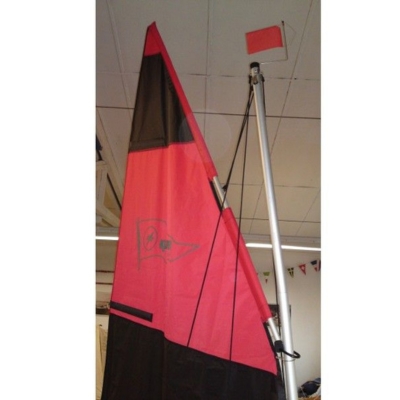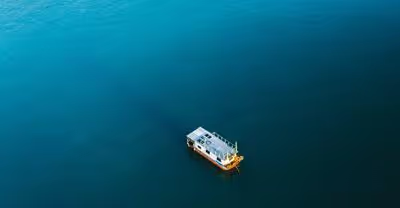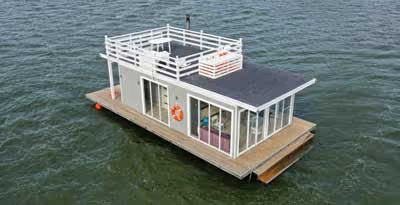
Key Takeaways
- Red sails have historical roots but have become popular due to synthetic sail materials.
- They are used in several racing events to enhance visibility and participation.
- Red sails are stylish and eye-catching for boaters who want their vessels to stand out.
Painting the seas' scarlet-red sails' vibrant stories, dive into the world of maritime magic. Let’s find out the red sails!
Red sails on a boat symbolize adventure, courage, and a willingness to stand out. They catch attention, signaling a bold spirit on the water. Red sails signify a vessel that dares to be different and embraces the thrill of the journey.
You're in the right place with me as your trusted expert. My expertise is rooted in the latest insights bolstered by the endorsement of the leading experts in the field. With this combination, we're poised to delve deep into the subject, armed with the most recent and high-quality information.
What Do Red Sails On Boats Mean?
Red sails on boats have a fascinating history and various associated meanings. Historically, sails were treated with materials like tar. As time progressed and synthetic fibers were introduced, the option to choose different sail colors expanded, with red becoming a popular choice.
Nowadays, red sails have multiple purposes, including serving as a visual indicator during man-racing events and regattas. Additionally, red is an eye-catching choice that adds a touch of flair and style to a boat, making it stand out from others in the water.
While the allure of red sails has evolved, it's clear that their historical origins, rights, and practical uses have contributed to the prevalence of vibrant crimson sails on boats today.
Historical Context
The tradition of red sails dates back to ancient maritime history and is rooted in the evolution of sailing vessel designs. Sailors have chosen different colors for their sails to match cultural preferences and practical needs.
The Tradition of Red Sails
The use of red sails became prominent mainly due to the type of fiber used in the manufacturing process of the sails. For instance, Viking sailing ships and Chinese Junk rigs often had red sails, which contributed to the distinctive appearance of these vessels.
The color red in sails was not just an aesthetic choice; it also had functional purposes. Red sails were typically made from natural fibers treated with tannins derived from tree bark, which helped to preserve the sails against harsh weather conditions and microbial growth.
Modern sailboats might showcase red sails as a nod to their historical counterparts or simply as a stylistic preference. Red sails can serve a functional purpose by providing better visibility and enhancing the sailing experience.
Materials Used for Red Sails
Using natural and synthetic materials showcases the evolution of sail construction and the dedication to preserving the beauty and tradition of this timeless pastime.
Natural Materials
Cotton, wool, and linen were the most commonly used natural materials for sailing boats. These materials come from plants and animals, making them biodegradable and more environmentally friendly.
Cotton and linen are plant-based fibers, while wool is derived from sheep. Cotton was famous for its durability and resistance to wear and tear, especially in harsh sailing conditions. On the other hand, Linen was known for its strength and long-lasting properties.
Synthetic Materials
Today, synthetic materials are widely used for sail construction, replacing the once-popular natural materials. Synthetic materials, such as polyester and Dacron, are now the go-to choices for sailing yachts and sailboats of various sizes.
Polyester is a versatile and strong synthetic fiber that provides excellent resistance to UV damage, making it suitable for long-lasting use in the sun. Dacron is a type of polyester known for its toughness and structural stability, making it ideal for sail applications.
Types of Red Sails
Red sails add a unique visual appeal to a boat and serve various functions depending on their design. The main types of red sails include the mainsail, jib, genoa, and spinnaker.
Mainsail
Mainsail
The mainsail is the primary sail on a sailing boat and is responsible for most propulsion. It is a fore-and-aft rig that runs along the boat's length and is usually triangular. A red mainsail can make the sailboat more distinctive and easier to spot on the water.
Jib
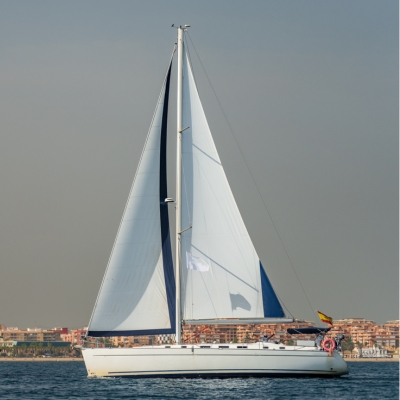
Jib
A jib is another type of triangular sail, but it is set ahead of the foremast. Its primary function is to help the sailing yacht point closer to the summer wind and improve its efficiency when sailing upwind. Red jibs enhance the boat's aesthetics and offer increased visibility in various sailing conditions.
Genoa
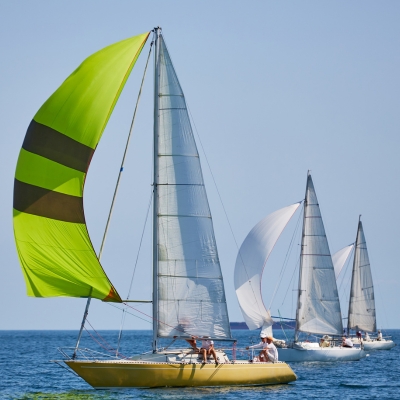
Genoa
The genoa is a larger version of the jib, often reaching past the mast and overlapping the mainsail. This design provides additional sail area and is particularly useful for generating more power in light air or when sailing downwind.
Spinnaker

Spinnaker
A spinnaker is a large, balloon-shaped sail designed for catching more wind when sailing downwind. This type of sail is typically seen in racing sailboats or cruising boats aiming for maximum speed in favorable conditions.
Here’s a table summary of types of red sails:
The Importance of Sail Plans
A sail plan is crucial to a sailing boat's overall performance and handling. It contains information about the placement and arrangement of sails, the rig types, and the running and standing rigging details.
Running and Standing Rigging
A well-designed sail plan and appropriately matched running and standing rigging allow for greater control and efficiency in a sailing boat. Depending on their specific needs and preferences, Sailors can use various rigs.
Running Rigging
The running rigging components allow adjustments to the sail's shape, angle, and position to optimize performance based on wind conditions and sailing objectives. Examples of running rigging include the halyards, sheets, and control lines like the cunningham, vang, and outhaul.
Standing Rigging
The standing rigging stern consists of the wires and cables supporting the boat's masts and spars. This rigging remains mostly stationary when the sailboat is underway, providing structural integrity to keep the mast and spars in their proper position.
Sailing in Different Conditions
Various conditions can significantly impact the water experience. One of these factors is the color of the sail on the boat. Red sails, for instance, have their unique advantages in specific scenarios.
Benefits of Red Sails in Races
Red sails on a sailing boat can provide a competitive edge during races. They offer improved visibility, as the color red stands out well against the blue sky and sea, helping to minimize the chances of collisions.
This increased visibility also aids the crew in tracking the boat's close range relative to the competitor's background. The symbol on the sail can make it easier for spectators and race officials to identify the boat from a distance.
Moreover, red sails can improve the performance of the sailboat. The color red is known to absorb more sunlight, leading to a warmer sail. This warmth can help to reduce the sail's weight, as it evaporates any moisture that may have accumulated.
Weathering Storms with Red Sails
Sailing in stormy weather can be a challenging world. The use of red sails can be advantageous in such conditions, offering various benefits that can help the crew manage the boat more effectively.
A storm sail is a smaller, stronger sail designed for use in heavy weather. Its reduced size lowers the windage on the sailing ship, helping to maintain balance and reduce the weather helm. In this context, using a red storm sail provides an additional layer of ease in monitoring the sail's start condition.
Storms often bring low visibility, strong winds, and rough seas. A red sail would contrast nicely against dark and gloomy skies, helping the crew keep an eye on their sail shore and ensuring it's properly trimmed and functioning as intended.
Visibility and Aesthetic Considerations for the Red Sail
Regarding sailboats, there is more to consider than functionality. One striking feature that often catches the eye is the color of the sail pictures, with red sails being especially noticeable.
Increased Visibility
The most compelling reason for red boat sails on the sailboat’s board is improved visibility. Red boat sails tend to stand out against the blue sky and green water, making it easier for boaters to spot the sailboat from a distance.
This advantage is particularly crucial in busy waterways or sailing races. Furthermore, enhanced visibility can lead to a safer sailing experience overall.
Aesthetic Appeal
Besides the practical aspect of visibility, red sails also contribute to the sailboat's aesthetics and style. Distinctive colors like red can display an owner's taste and make a strong statement on the water. Additionally, a boat with red sails may become easier to identify for fellow sailors and others watching from a distance.
Historical Significance
In some cases, red sails may also have historical roots. For example, the traditional Chinese junk boat had an iconic red sail design that has been preserved over time, reflecting the cultural heritage of the vessel and showing respect for ancient maritime traditions.
Embroidered Insignias and Arcs
Some red sailboats might feature a logo or decorated arc on their red sails. These elements may represent a particular sailing club, organization, or even a specific event. This display can add a unique touch to the sailboat and make it easily recognizable among other vessels.



